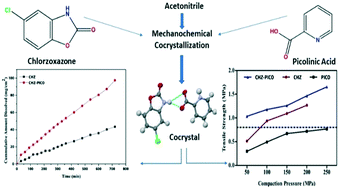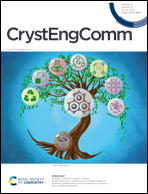Mechanochemical cocrystallization to improve the physicochemical properties of chlorzoxazone†
Abstract
Chlorzoxazone (CHZ) is a centrally acting muscle relaxant used for the treatment of muscle spasm. According to the Biopharmaceutics Classification System (BCS), it belongs to class II drugs having poor solubility and high permeability. In the present study, mechanochemical cocrystallization has been explored to prepare chlorzoxazone–picolinic acid (CHZ–PA) cocrystals with an aim to improve their poor physicochemical properties. The prepared cocrystal was thoroughly characterized by SCXRD, PXRD, DSC, TGA and FTIR. To understand the changes in solubility and dissolution, equilibrium solubility and intrinsic dissolution rate studies were performed and the results were compared to native CHZ. The CHZ–PA cocrystals showed improved solubility in different pH media along with an increased dissolution rate. Tabletability studies were performed for the prepared cocrystal to investigate the powder compaction behaviour. The CHZ–PA cocrystals showed improved powder compaction properties compared to the native form of CHZ. FESEM studies revealed the changes in the surface morphology of the CHZ–PA cocrystals. Further, accelerated stability studies were performed to demonstrate that the prepared cocrystals were stable under accelerated storage conditions for up to thirteen weeks. The study demonstrates the significance of mechanochemical cocrystallization as a green synthesis approach to improve the physicochemical properties of an active pharmaceutical ingredient.



 Please wait while we load your content...
Please wait while we load your content...